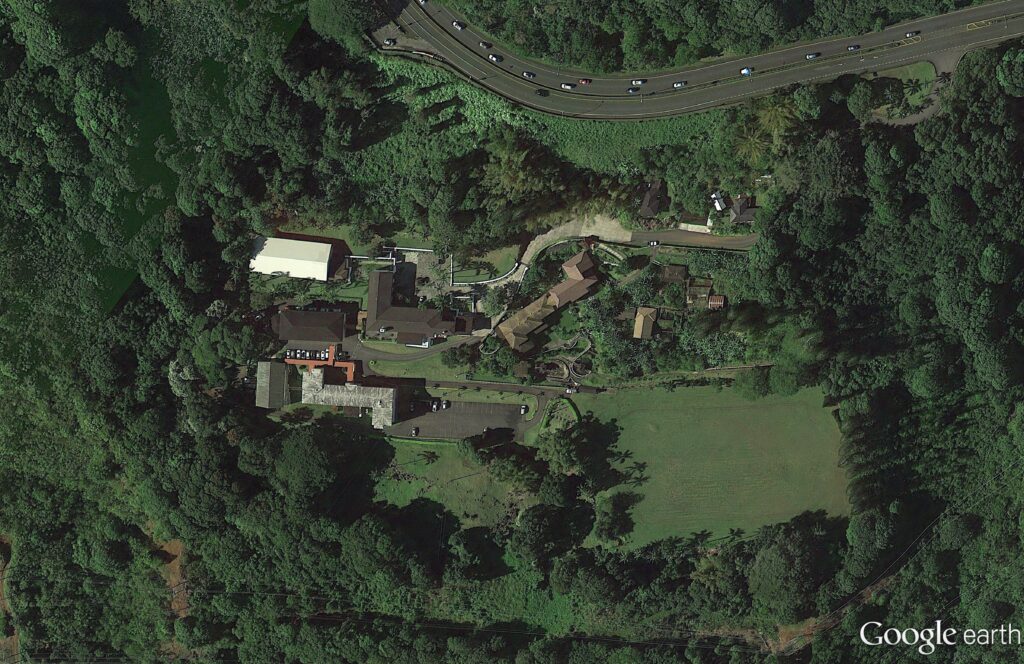About 6,000 years ago and before the arrival of the Hawaiians, Kawainui (the large [flow of] fresh water) and Ka‘elepulu (the moist blackness) were bays connected to the ocean and extended a mile inland of the present coastline (as indicated by inland deposits of sand and coral.)
A sand bar began forming across Kawainui Bay around 2,500 years ago creating Kawainui Lagoon filled with coral, fish and shellfish. The Hawaiians probably first settled along the fringes of this lagoon. Gradually, erosion of the hillsides surrounding Kawainui began to fill in the lagoon with sediments.
About 500 years ago, early Hawaiians maintained a freshwater fishpond in Kawainui; the fishpond was surrounded on all sides by a system of ʻauwai (canals) bringing water from Maunawili Stream (winding/twisted mountain) and springs to walled taro lo‘i (irrigated fields.)
In 1750, Kailua (two seas (probably two currents)) was the Royal Center of power for the district of Koʻolaupoko and a favored place of the O‘ahu chiefs for its abundance of fish and good canoe landings (and probably enjoyed the surf, as well.) Kawainui was once the largest cultivated freshwater fishpond on Oʻahu.
Farmers grew kalo (taro) in the irrigated lo‘i along the streams from Maunawili and along the edges of the fishponds. Crops of dryland kalo, banana, sweet potato and sugarcane marked the fringes of the marsh. Fishermen harvested fish from the fishponds and the sea.
In 1845 the first road was built over the Nuʻuanu Pali (cool height – cliff) to connect Windward Oʻahu with Honolulu. It was jointly financed by the government and sugar planters who wanted easy access to the fertile lands on the windward side of Oʻahu. Kamehameha III and two of his attendants were the first to cross on horseback.
(In 1898 this road was developed into a highway and was later replaced by the Pali Highway. When the current Pali Highway and its tunnels opened (1959,) the original roadway was closed and is now used by hikers.)
A story has it that Olomana was a giant and imposing warrior that ruled the area between Makapuʻu and Kualoa, in Windward Oʻahu.
Olomana was famous for his great strength and his enormous height. ʻAhuapau, the king of Oʻahu, was in fear of this man and because of this he never traveled to Koʻolau. From the Makapuʻu point to the Kaʻoio point, at Kualoa, was kapued and sacred to Olomana. (Fornander)
“Olomana was twelve yards, or six fathoms in height, if standing and measured from the head to the feet.“
When Palila arrived at the top of the Nuʻuanu cliff he laid down his club and sped on till he reached Kaʻelepulu, the place where Olomana was standing.
In this flight of the club, Palila seized hold of the end and was carried by it until he lit on the shoulder of Olomana, whereupon Olomana asked Palila: “Where are you from, you most conceited boy? for my shoulder has never been stepped on by anybody, and here you have gone and done it.” (Fornander)
Palila replied: “I am from the kapued temple; from Alanapo in Humuula, Kauai. My name is Palila and I am a soldier.” When Olomana heard this he was afraid and begged of Palila that he be saved. (Fornander)
Palila, however, refused saying: “You shall not live.”
Palila slayed Olomana by cutting him in half.
Mount Olomana was formed as a result of a sensational battle between Olomana and Palila, a warrior sent by ʻAhuapau, the King of Oʻahu, to slay Olomana. (KIS)
Part of Olomana became Mount Olomana; the other part of Olomana ended up on the far side of Kawainui as Mahinui, the ridge separating Kāneʻohe from Kawainui, where Kalaheo High School is located.
Olomana (“forked hill”) is actually three peaks; the tallest peak, 1,643-feet high, is named after the legendary giant, Olomana.
The second flat-topped peak is Pakuʻi at 1,520-feet named after the konohiki for the adjacent fishponds of Ka’elepulu (at what is now generally referred to as Enchanted Lake) and the third knife-edged peak is Ahiki at 1,480-feet (nearest Waimānalo) named after the warrior Olomana’s konohiki or overseer responsible for the wetlands of Kawainui.
Geologists note Olomana is a residual ridge, a remnant of the old Koʻolau volcano. (Other remnants of that volcano include Keolu Hills and the Mokulua Islands.) (SOEST)
Olomana seems to be a favorite for hikers. They say it’s for intermediate to expert level hikers. The trail is approximately 2.5-miles long. The terrain is rugged with many areas only passable with the aid of ropes.
When we lived in Kailua we had a clear view of Olomana; from our house, we could see silhouettes of folks on Olomana’s peak. Likewise, we regularly saw helicopters hovering over the area, rescuing another of these hikers.








































































